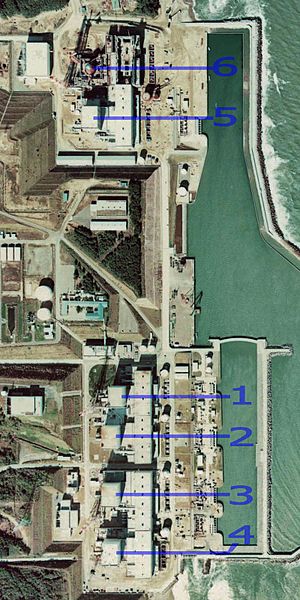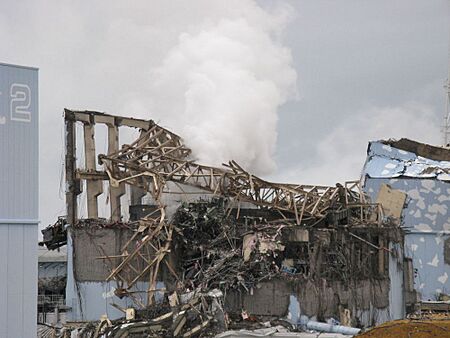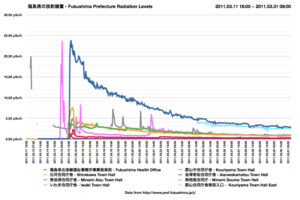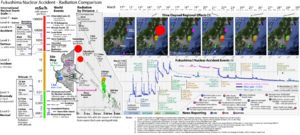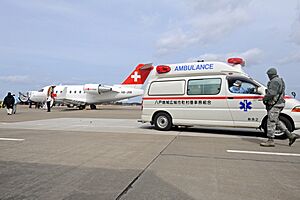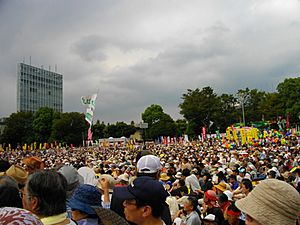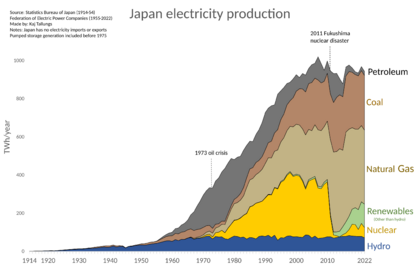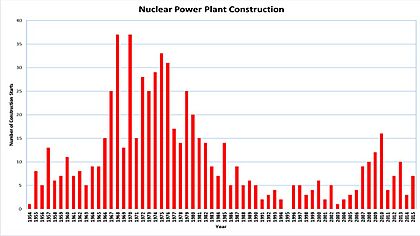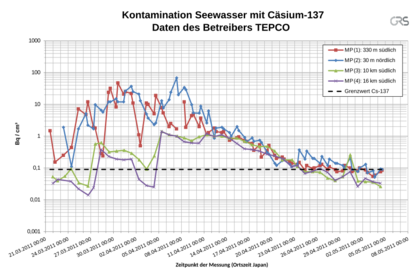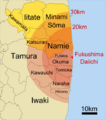Fukushima nuclear accident facts for kids
Quick facts for kids Part of the 2011 Tōhoku earthquake and tsunami |
|
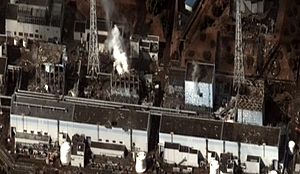
The four damaged reactor buildings (from left: Units 4, 3, 2, and 1) on 16 March 2011. Hydrogen-air explosions in Units 1, 3, and 4 caused structural damage.
|
|
| Date | 11 March 2011 |
|---|---|
| Location | Ōkuma and Futaba, Fukushima, Japan |
| Outcome | INES Level 7 (major accident) |
| Non-fatal injuries | 6 with cancer or leukemia, 16 with physical injuries due to hydrogen explosions. 2 workers hospitalized with radiation burns |
The Fukushima nuclear accident was a very serious nuclear accident. It happened at the Fukushima Daiichi nuclear power plant in Ōkuma, Fukushima, Japan. The accident started on March 11, 2011.
The main reason for the accident was the 2011 Tōhoku earthquake and tsunami. This powerful earthquake and huge wave caused a massive electrical grid failure. It also damaged almost all of the power plant's backup power sources. Because the reactors could not be cooled enough after they shut down, radioactive materials were released into the environment.
The accident was given a Level 7 rating on the INES. This is the highest level of severity. It is considered the worst nuclear event since the Chernobyl disaster in 1986. That accident also received an INES Level 7 rating.
According to the United Nations Scientific Committee on the Effects of Atomic Radiation, no health problems have been directly linked to radiation from the accident among people living in Fukushima. One person received money for a death from lung cancer. However, it's not proven that radiation caused this cancer. Six other people have been reported to have cancer or leukemia. Two workers were treated in the hospital for radiation burns. Other people had physical injuries from the accident.
Some people have criticized how the public reacted to radiation dangers. They also questioned the evacuations, saying they caused more harm than good. After the accident, at least 164,000 people living nearby had to leave their homes. This caused at least 51 deaths, mainly from stress and fear.
Investigations found that safety rules were not followed. There were problems with checking risks and planning for evacuations. There is also a lot of debate about how to get rid of the treated water used to cool the reactors. This has led to protests in nearby countries.
How the Plant Worked
The Fukushima Daiichi Nuclear Power Plant had six General Electric (GE) light water boiling water reactors (BWRs). These reactors used water to cool the nuclear fuel.
When the Tōhoku earthquake hit on March 11, 2011, units 1, 2, and 3 were running. However, the spent fuel pools in all units still needed to be cooled.
Materials Inside the Reactor
Many parts inside the reactor, like the fuel rods, were made from a special metal called zirconium alloy (Zircaloy). This metal is usually safe. But if it gets too hot (above 1200 degrees Celsius), it can react with steam. This reaction creates hydrogen gas. This gas can cause explosions if it mixes with air.
Cooling Systems for Emergencies

In an emergency, the reactor automatically switches to a special cooling system. This system can cool the reactor without needing outside electricity. One system, called the Isolation Condenser (IC), used the reactor's own pressure to move steam. The steam would cool down and then flow back into the reactor.
Newer units had a different system called Reactor Core Isolation Cooling (RCIC). This system used steam to power a pump. The pump would then inject water from a storage tank into the reactor. This system could work on its own for several hours. However, it still needed some electricity to control its valves.
If these main cooling systems failed, workers could try to release steam from the reactor. This would lower the pressure. Then, they could use fire hoses to pump water into the reactor.
Backup Power on Site
If the main power from the electricity grid was lost, emergency diesel generators (EDGs) would start automatically. These generators provided backup electricity. Most of these EDGs were in the basements of the buildings, close to the ocean. They used seawater for cooling.
The power plant also had backup batteries. These batteries could power the plant for about 8 hours. Some batteries were in the basements, while others were on higher floors.
Fuel Storage
The power plant had many fuel rods. Some were in the reactors, some were used (spent fuel), and some were new.
| Location | Unit 1 | Unit 2 | Unit 3 | Unit 4 | Unit 5 | Unit 6 | Central storage |
|---|---|---|---|---|---|---|---|
| Reactor fuel assemblies | 400 | 548 | 548 | 0 | 548 | 764 | N/A |
| Spent fuel assemblies | 292 | 587 | 514 | 1331 | 946 | 876 | 6377 |
| New fuel assemblies | 100 | 28 | 52 | 204 | 48 | 64 | N/A |
Earthquake Safety
The power plant was built to withstand strong earthquakes. After a 1978 earthquake, engineers checked the plant and found no damage to important parts. They later updated the design to handle even stronger shaking.
The Accident
The Earthquake Strikes
A huge 9.0 magnitude earthquake hit Japan on March 11, 2011, at 2:46 PM. Its center was off the east coast. The earthquake caused strong shaking at the power plant.
When the earthquake was detected, all three operating reactors (units 1, 2, and 3) automatically shut down. The plant's backup diesel generators started up. The emergency cooling systems also turned on.
Tsunami and Power Loss
About 50 minutes after the earthquake, a massive tsunami hit the plant. The largest wave was 13–14 meters (43–46 feet) high. This wave went over the seawall, which was 10 meters (33 feet) high.
The waves first damaged the seawater pumps along the shore. These pumps cooled 10 of the 13 emergency diesel generators. Then, the waves flooded the turbine and reactor buildings. This damaged the remaining generators and other electrical parts in the basements. Only one air-cooled generator for unit 6 kept working. The backup batteries for units 1, 2, and 4 also stopped working.
So, units 1–5 lost all their main power. Units 1, 2, and 4 also lost their battery power. Workers then thought that units 1 and 2 were losing coolant. They planned to release steam and pump water in with fire equipment. Two workers died because of the tsunami.
What Happened at Each Reactor
Unit 1
Unit 1's cooling system (IC) was working before the tsunami. But after the tsunami, the control valves closed automatically because of power loss. Workers tried to open them, but the system didn't work.
The pressure inside the reactor became very high. Workers tried to pump water in with fire equipment, but the pressure was too high. They also found high radiation levels, meaning the reactor core was damaged. They decided to release steam to lower the pressure. This was done by 2:00 PM on March 12.
Workers then tried to pump water into the reactor again. But the fire pump was broken. A fire truck had to be connected, which took about 4 hours. Freshwater was finally pumped in starting at 4:00 AM on March 12. Later, seawater was used when the freshwater ran out.
At 3:36 PM on March 12, a hydrogen explosion damaged the building around Unit 1. This explosion damaged the mobile power generator and the seawater lines. Seawater injection stopped for 18 hours. This long period without cooling likely caused the fuel in Unit 1 to melt.
Unit 2
Unit 2 also lost all its power. Its cooling system (RCIC) worked well at first. Workers thought it might be losing coolant, but a team found the RCIC was still working.
However, the water tank for the RCIC was almost empty. So, the system was changed to use water from another part of the reactor.
On March 13, Unit 2 was set up to release steam automatically. Plans were made to pump in seawater if needed. But an explosion at Unit 3 the next day damaged the seawater pump setup.
On March 14, Unit 2's RCIC pump stopped after working for 68 hours. There was no way to release steam. Workers tried to lower the pressure to allow seawater to be pumped in.
On March 15, another explosion was heard at the site. Most workers left because of the high radiation danger.
Unit 3
Unit 3 lost its main power, but some battery power remained. Workers used this to keep the RCIC system cooling the reactor. They also saved battery power by turning off unneeded equipment.
On March 14, the RCIC system failed. Another system (HPCI) was used, and workers tried to spray water into the containment building to cool it down.
Workers had trouble lowering the pressure in the reactor to pump water in. They used batteries from cars to operate valves and release steam. This allowed water to be pumped in.
However, cooling was lost again when the water supply ran out. An explosion happened in the Unit 3 building at 11:01 AM on March 14. This explosion damaged water lines and delayed cooling for Unit 1. Cooling for Unit 3 resumed later that afternoon but was lost again when the site was evacuated.
Unit 4
Unit 4 was not running and had no fuel in its reactor. However, its spent fuel pool (SFP) held many used fuel rods.
On March 15, an explosion happened at the Unit 4 building during the evacuation. This explosion likely happened because hydrogen gas from Unit 3 traveled through shared pipes.
Later, a helicopter check showed there was still enough water in the SFP. On March 20, water was sprayed into the SFP to keep the fuel cool.
Unit 5
Unit 5 was not running, but it had fuel in its reactor. It was being tested at the time. The water in its reactor was enough to keep the fuel cool. On March 13, main power was restored to Unit 5. It was the first unit to be completely shut down safely on March 20.
Unit 6
Unit 6 was also not running. Only one of its backup generators was working after the tsunami. This allowed Unit 6 to keep its safety systems powered. It was safely shut down on March 20, shortly after Unit 5.
On March 21, the temperature in the shared fuel pool rose a bit. Water was sprayed over it. Power was restored to its cooling systems on March 24. By March 28, the temperature was back down to normal.
Release of Radioactive Material
The accident released radioactive materials like caesium-137, iodine-131, and xenon-133 into the air. Much of the caesium-137 that went into the air ended up in the ocean.
A lot of radioactive material also leaked directly into the groundwater and then into the ocean. The ocean currents helped spread this radioactivity far into the Pacific Ocean. By late 2011, scientists thought the effect on sea life would be small. However, some fish caught near the plant still show contamination.
What Happened After
Evacuation

About 2,220 patients and elderly people were in hospitals and nursing homes within the 20 km (12.4 miles) evacuation zone. Of these, 51 deaths were linked to the evacuation itself. One person was thought to have died from lung cancer possibly caused by radiation, four years later. More than 1,700 deaths, mostly among older people, were linked to stress from the evacuation.
Communication Problems
Early on, information about the accident was not shared well. The government was criticized for delaying data to the U.S. military. Also, a detailed map from the U.S. military was not shared with the public for a week.
TEPCO, the company running the plant, was told not to use the words "core meltdown." They only officially admitted the meltdown two months after it happened.
The Japanese government did not keep records of important meetings during the crisis. Emails with evacuation advice were not read and were deleted.
Mental Health and Evacuation Effects
In January 2015, about 119,000 people were still displaced from their homes. This number peaked at 164,000 in June 2012. Studies suggest that if people had stayed home or sheltered in place, fewer lives might have been lost.
Many people who were evacuated felt stressed and anxious. A 2012 survey found that 60% of evacuees felt their health had gotten worse. Many families were separated. People also reported less sleep and more smoking.
Stress can lead to physical problems. People who lost homes or family members faced many mental and physical challenges. A lot of this stress came from not having enough information and from having to move.
A 2014 study found that many people in the affected areas experienced depressive symptoms, anxiety, sleep problems, and post-traumatic stress disorder. The number of people with psychological distress was five times higher than the Japanese average. Children in the area also saw an increase in obesity. This was because they were told to stay indoors instead of playing outside.
Energy Policy Changes
Before the accident, nuclear power produced over 25% of Japan's electricity. Japan had planned to increase this to 50%. But after the accident, this plan was dropped. Japan decided to reduce its reliance on nuclear power.
By 2013, all nuclear reactors in Japan were shut down. This meant Japan had to import more fossil fuels to make electricity. This caused a trade deficit for Japan for the first time in decades.
Elections and Nuclear Power
In December 2012, Japan held an election. The new Prime Minister, Shinzō Abe, supported nuclear power. He said keeping the plants closed was costing Japan a lot of money. Many local mayors also agreed to restart reactors if the government could guarantee their safety.
However, many people protested against restarting nuclear power plants. Former Prime Minister Naoto Kan became against nuclear power after the accident. He ordered an older plant closed and said Japan should get rid of nuclear energy.
Global Impact
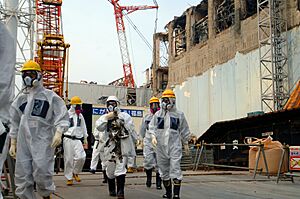
The Fukushima accident caused worry about nuclear power around the world. The International Atomic Energy Agency (IAEA) said that Japan had underestimated tsunami risks at its nuclear sites.

After the accident, Germany decided to close all its nuclear reactors by 2022. Belgium and Switzerland also decided to stop using nuclear energy. Italy voted against building new nuclear power plants. France announced plans to reduce its nuclear energy use.
China briefly stopped its nuclear development program but restarted it soon after. China plans to greatly increase its nuclear power capacity by 2050.
Some countries, like the UK, Russia, India, and South Korea, continued to build new nuclear power plants. India's Vice President said nuclear energy was the "only option" for expanding energy supplies.
| Year | Generation (TWh) |
|---|---|
| 2010 |
23.0
|
| 2011 |
32.3
|
| 2012 |
33.1
|
| 2013 |
33.3
|
| 2014 |
34.7
|
| 2015 |
38.4
|
| 2016 |
38.0
|
Radiation Effects on People
People living near the accident site were exposed to small amounts of radiation. For example, residents of Fukushima City received about 4 mSv in the year after the accident. For comparison, a person receives about 170 mSv of natural background radiation over their lifetime.
Experts believe very few cancers will happen because of this radiation. People who were evacuated were exposed to so little radiation that health effects are unlikely to be noticed. There has been no increase in miscarriages, stillbirths, or birth defects in babies born after the accident.
Outside the areas most affected by radiation, even in locations within Fukushima prefecture, the predicted risks remain low, and no observable increases in cancer above natural variation in baseline rates are anticipated.
The World Health Organization (WHO) and other groups were concerned about thyroid cancer. In January 2022, six people who were children during the accident sued TEPCO. They developed thyroid cancer.
The WHO studied other cancers like leukemia and breast cancer. They found a small increase in the lifetime risk for infants.
| Cancer Type | Risk Increase Compared to Normal |
|---|---|
| All Solid Cancers | 4% |
| Leukemia | 7% |
| Thyroid Cancer | 70% |
The WHO noted that the large increase in thyroid cancer risk is partly because the normal rates are very low.
Radiation Effects on Animals
On March 21, 2011, rules were put in place to stop people from selling or eating contaminated food. Scientists thought the effects on sea life would be minor. Even though caesium levels in the water were higher, the radiation risks were considered safe for marine animals and people eating them.
Studies found higher levels of caesium in sea life from 2011 to 2015. Fish that travel long distances can carry pollutants. For example, higher levels of Cs-134 were found in tuna off the coast of California. However, the amount of radioactivity was less than what is naturally found in a single banana.
In February 2018, Japan started exporting fish from Fukushima again. Officials said no seafood had radiation levels above safety standards since April 2015. However, in February 2022, Japan stopped selling black rockfish from Fukushima. One fish had 180 times more radioactive Cesium-137 than allowed. This fish likely escaped from the accident site.
Investigations
Three investigations found that the accident was caused by human mistakes. They pointed to problems with safety rules and a "network of corruption." A New York Times report said that Japan's nuclear regulators often sided with the nuclear industry.
In 2016, three former TEPCO executives were charged with not doing enough to prevent the accident. They said they were not guilty, and in September 2019, the court agreed.
NAIIC Report
The Fukushima Nuclear Accident Independent Investigation Commission (NAIIC) was the first independent investigation by Japan's parliament.
The NAIIC chairman, Kiyoshi Kurokawa, wrote that the accident "cannot be regarded as a natural disaster." He said it was a "man-made accident" that could have been prevented. He also said that the government, regulators, and TEPCO did not take enough responsibility to protect people. He felt the accident was "made in Japan" because of certain cultural traits, like always following authority and not questioning things.
The Commission recognized that people affected by the accident were still struggling. They faced concerns about radiation, being displaced, and their lives being disrupted.
ICANPS Report
The Investigation Committee on the Accident at the Fukushima Nuclear Power Stations (ICANPS) looked into the causes of the accident. They wanted to find ways to prevent similar events.
The committee found problems with the legal system for nuclear crisis management. They also noted confusion in how the government and TEPCO handled the crisis. The report concluded that a relaxed attitude about nuclear safety and poor crisis management led to the accident.
Cleanup and Recovery
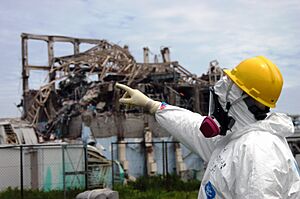
To ease fears, the government ordered the decontamination of many areas. This meant cleaning areas where radiation levels were higher than a certain amount. The government also tried to teach people more about radiation effects.
In 2018, tours to the accident area began. In September 2020, a memorial museum opened near the power plant. It shows items and videos about the earthquake and the nuclear accident.
Removing Fuel
Tokyo Electric Power Company (TEPCO) plans to remove all the nuclear fuel from the plants. They finished removing fuel from Unit 4's spent fuel pool in 2014 and Unit 3's in 2021. TEPCO plans to remove all fuel rods from the other spent fuel pools by 2031. They also plan to remove the melted fuel from the reactors of Units 1, 2, and 3 by 2040 or 2050. The cleanup and decommissioning of the plant is expected to take 30 to 40 years.
Treating Contaminated Water
A lot of cooling water is pumped into the reactors every day. Also, groundwater seeps into the buildings. This contaminated water is treated to remove radioactive materials, except for tritium. This treated water then needs to be released into the Pacific Ocean. TEPCO built an underground ice wall to stop groundwater from flowing into the reactor buildings.
As of October 2019, 1.17 million cubic meters of contaminated water was stored at the plant. The water is purified to meet Japanese safety rules for discharge into the sea. However, tritium cannot be removed from the water.
A government committee in 2020 said the purified water should be released into the sea or evaporated. They calculated that releasing all the water into the sea in one year would cause a very small radiation dose to local people. For comparison, Japanese people get much more radiation from natural sources each year. The IAEA agreed that the dose calculation was correct.
In July 2022, Japan's Nuclear Regulation Authority approved releasing the treated water into the sea. Japan says the water is safe, and many scientists agree. The UN's nuclear watchdog also approved the plan. However, critics want more studies and for the release to be stopped. In August, Japan began releasing the treated water into the Pacific Ocean. This caused protests in the region and China stopped importing seafood from Japan. The discharges are planned to happen over the next 30 years.
Costs and Compensation
The cost to Japanese taxpayers was first estimated to be over 12 trillion yen. By December 2016, the government estimated the total costs for cleanup, compensation, and decommissioning would be 21.5 trillion yen. By 2022, 12.1 trillion yen had already been spent.
In March 2017, a Japanese court ruled that the government was partly responsible for the accident. This was because it failed to make TEPCO take preventive measures. The court ordered the government to pay money to people who had to leave their homes. In March 2022, Japan's Supreme Court upheld an order for TEPCO to pay 1.4 billion yen to about 3,700 people affected by the accident.
Changes to Equipment and Operations
The accident taught many lessons about nuclear safety. One clear lesson was that seawalls in tsunami-prone areas must be tall and strong enough. The Onagawa Nuclear Power Plant, which was closer to the earthquake, had a 14-meter (46-foot) seawall. It survived the tsunami without serious damage.
Nuclear power plants around the world started installing new safety devices. These include "passive autocatalytic recombiners" (PARs). These devices turn explosive gases like hydrogen into water without needing electricity. If these had been at Fukushima, the explosions might not have happened.
New filtering systems were also added to vent lines. These systems can safely capture radioactive materials when steam and hydrogen are released.
For older reactors in flood areas, having more than 3 days of backup batteries became a standard. Also, backup diesel generator rooms are now built with strong, waterproof doors.
Newer reactor designs use "passive nuclear safety." This means they use natural forces like convection (hot water rises) and gravity (water falls) to keep the reactor cool without pumps.
During the crisis, Japan asked the U.S. military for robots. These robots took pictures inside the damaged plants. But they couldn't do all the tasks human workers normally would. This showed that robots needed to be more skilled and tougher. This led to new efforts to develop humanoid robots for disaster relief.
Warnings Before the Accident
On July 5, 2012, the NAIIC found that the causes of the accident could have been foreseen. TEPCO had failed to meet basic safety rules. This included checking risks and planning for emergencies. The IAEA also said that Japan's Ministry of Economy, Trade and Industry had a conflict of interest. It was in charge of both regulating and promoting nuclear power. In October 2012, TEPCO admitted it had not taken necessary safety steps. They feared lawsuits or protests.
Tsunami Studies
In 1991, the U.S. Nuclear Regulatory Commission warned about the risk of losing emergency power. In 2000, a TEPCO report suggested safety measures against seawater flooding from a 50-foot tsunami. But TEPCO did not act on this. They worried it would make people anxious about the plant's safety.
In 2002, government research estimated a tsunami up to 15.7 meters (51.5 feet) could hit the plant. In 2008, another TEPCO study found an urgent need to protect the plant from seawater flooding. This study used the 2002 tsunami estimate.
Unit 1 Generator Failure in 1991
On October 30, 1991, one of Unit 1's emergency generators failed. This happened because of a water leak that flooded the room. An engineer warned that a tsunami could damage the generators. In response, TEPCO installed doors to prevent water from leaking into the generator rooms.
See also
 In Spanish: Accidente nuclear de Fukushima I para niños
In Spanish: Accidente nuclear de Fukushima I para niños
- Comparison of the Chernobyl and Fukushima nuclear accidents
- Environmental issues in Japan
- Fukushima disaster cleanup
- Fukushima Daiichi nuclear disaster casualties
- List of Japanese nuclear incidents
- List of civilian nuclear accidents
- Lists of nuclear disasters and radioactive incidents
- Nuclear power in Japan
- Nuclear power phase-out
Images for kids
-
The town of Namie (population 21,000) was evacuated as a result of the accident.
-
Anti-nuclear power plant rally on 19 September 2011 at the Meiji Shrine complex in Tokyo.
-
IAEA experts at Unit 4, 2013.
-
Protest against nuclear power in Cologne, Germany on 26 March 2011.
-
IAEA team examining Unit 3.


